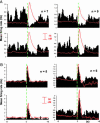Simultaneous dopamine and single-unit recordings reveal accumbens GABAergic responses: implications for intracranial self-stimulation
- PMID: 16380429
- PMCID: PMC1323210
- DOI: 10.1073/pnas.0509607102
Simultaneous dopamine and single-unit recordings reveal accumbens GABAergic responses: implications for intracranial self-stimulation
Abstract
Intracranial self-stimulation (ICS) is a motivated behavior that results from contingent activation of the brain reward system. ICS with stimulating electrodes placed in the medial forebrain bundle (MFB) is particularly robust. However, the neurons that course through this pathway use a variety of neurotransmitters including dopamine and GABA. For this reason, the neurotransmitters that are central to this behavior, and the specific roles that they subserve, remain unclear. Here, we used extracellular electrophysiology and cyclic voltammetry at the same electrode in awake rats to simultaneously examine cell firing and dopamine release in the nucleus accumbens (NAc) during ICS and noncontingent stimulation of the MFB. ICS elicited dopamine release in the NAc and produced coincident time-locked changes (predominantly inhibitions) in the activity of a subset of NAc neurons. Similar responses were elicited with noncontingent stimulations. The changes in firing rate induced by noncontingent stimulations were reversed by the GABA(A) receptor antagonist bicuculline. Most time-locked unit activity was unaffected by D1 or D2-like dopamine-receptor antagonists, or by inhibition of evoked dopamine release, although, for a minority of units, the D1 dopamine-receptor antagonist SCH23390 attenuated neural activity. Thus, neurons in the NAc are preferentially inhibited by GABA(A) receptors after MFB stimulation, a mechanism that may also be important in ICS.
Figures




References
-
- Berridge, K. C. & Robinson, T. E. (1998) Brain Res. Rev. 28, 309-369. - PubMed
-
- Schultz, W., Dayan, P. & Montague, P. R. (1997) Science 275, 1593-1599. - PubMed
-
- Self, D. W. & Nestler, E. J. (1998) Drug Alcohol Depend. 51, 49-60. - PubMed
-
- Bassareo, V. & Di Chiara, G. (1999) Neuroscience 89, 637-641. - PubMed
-
- Mogenson, G. J., Jones, D. L. & Yim, C. Y. (1980) Prog. Neurobiol. 14, 69-97. - PubMed
Publication types
MeSH terms
Substances
Grants and funding
LinkOut - more resources
Full Text Sources

